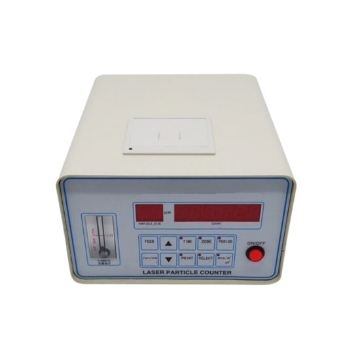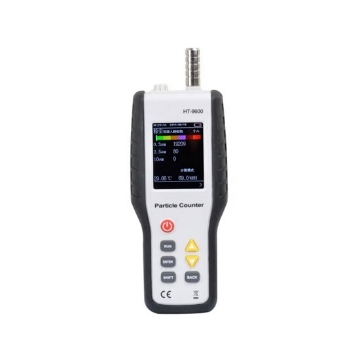Particle counters play a crucial role in various industries where monitoring and controlling air quality are essential. These instruments are designed to measure and classify particles based on different criteria. In this blog post, we will explore the various types of particle counters, their distinguishing features, and the industries where they find applications.
Particle counter classification method
Testing Principles:
Particle counters can be categorized based on the testing principles they employ. Common testing principles include:
- Light Scattering Method (White Light and Laser): This method uses scattered light to detect particles.
- Microscopy: Microscopic methods involve visual inspection of particles.
- Weight-based Methods: These measure the weight of collected particles.
- Differential Mobility Analysis (DMA): DMA is used for particle size analysis.
- Inertial Methods: Inertial particle counters rely on particle inertia for measurement.
- Diffusion Methods: These count particles based on their diffusion properties.
- Condensation Nucleus Counters (CNC): CNCs detect particles by forming condensation nuclei.
Among these methods, light scattering-based particle counters, often designed using laser or white light sources, are widely used today.
Flow Rates:
Particle counters can be classified based on their flow rates:
- Small Flow: 0.1 cfm or 2.83 L/min
- Large Flow: 1 cfm or 28.3 L/min
Form Factor:
Particle counters come in different form factors:
- Handheld: Handheld particle counters are compact and lightweight, making them easy to carry and operate in different locations.
- Desktop or Benchtop: Desktop or benchtop particle counters are specialized instruments designed for stationary, controlled, and laboratory-based particle monitoring.
Testing Channels:
Particle counters can be categorized by the number of testing channels they possess:
- Single Channel: measuring one particle size
- Dual Channel: measuring two particle sizes
- Multi-Channel: measuring multiple particle sizes
Features and Applications
Light Scattering Particle Counters
Features:
- Highly Sensitive: Light scattering particle counters are incredibly sensitive to the presence of particles in the air. They can detect even minute particles, making them ideal for environments where low particle levels are critical.
- Fast Response: These counters provide real-time or near-real-time data, allowing for immediate monitoring and response to changes in particle concentrations.
- Versatile for Various Particle Sizes: Light scattering particle counters can cover a wide range of particle sizes, making them suitable for applications with diverse particle size distributions.
Applications:

- Cleanrooms: Cleanrooms in industries like electronics manufacturing and pharmaceuticals require stringent control of airborne particles to maintain product quality. Light scattering particle counters, cleanroom particle counters help ensure these cleanrooms meet required particle cleanliness standards.
- Pharmaceutical Manufacturing: In pharmaceutical production, the presence of contaminants can affect the quality and safety of drugs. Particle counters are used to monitor and control particle levels in manufacturing areas.
- Semiconductor Fabrication: Semiconductor cleanrooms demand extremely low particle counts to prevent defects in microelectronics. These counters are essential for quality control.
- Indoor Air Quality Monitoring: Monitoring indoor air quality is vital for occupant health and comfort. Light scattering particle counters are used to assess and improve air quality in various indoor environments.
- Environmental Research: Researchers use these counters to study air quality in outdoor environments, such as tracking pollution levels and airborne particulate matter for environmental studies and pollution control.
Condensation Nucleus Counters (CNCs)
Features:
- Suitable for Detecting Submicron Particles: CNCs specialize in detecting ultrafine particles with sizes as small as 0.1 μm and even below. This makes them highly valuable for applications where these tiny particles need to be monitored.
- High Sampling Efficiency: CNCs efficiently capture and count particles, ensuring accurate data collection for research and analysis.
Applications:
- Research Laboratories: CNCs are commonly used in research settings to investigate ultrafine particles, nanoparticles, and aerosols. They contribute to various scientific studies, including atmospheric research and climate studies.
- Measuring Ultrafine Particles in Cleanrooms: In environments like semiconductor cleanrooms, where stringent control of ultrafine particles is crucial, CNCs are employed to maintain and verify particle levels.
- Aerosol Studies: Scientists and environmental researchers use CNCs to study the behavior of aerosol particles in the atmosphere, which has implications for climate science, air quality, and health studies.
Inertial Particle Counters
Features:
- Effective for Larger Particles: Inertial particle counters excel at counting larger particles, typically above 1 μm in size. They are robust instruments designed to handle these particles effectively.
- Rugged Design: These counters are built to withstand harsh environments and are often used in industrial settings.
Applications:
- Industrial Hygiene: In workplaces with potential exposure to larger particulate matter, such as dust or airborne contaminants, inertial particle counters help assess employee safety and compliance with occupational health standards.
- Workplace Safety: Monitoring air quality in industries like mining, construction, and manufacturing, where larger particles may pose health risks, is essential for worker safety.
- Monitoring Larger Particulate Matter in the Air: In outdoor environments or indoor settings where larger particles can impact air quality or product quality, inertial particle counters are employed for monitoring and control.
Particle counters come in various types, each tailored to specific testing principles, flow rates, form factors, and testing channels. Light scattering-based particle counters are the most prevalent due to their versatility and sensitivity. These particle counters play a critical role in ensuring air quality in cleanrooms, industrial settings, and environmental research. Additionally, condensation nucleus counters are essential for detecting ultrafine particles, while inertial particle counters are suitable for larger particles. Understanding the different types and their features is vital for selecting the right particle counter for specific applications, ultimately contributing to improved air quality and safety in various industries.

